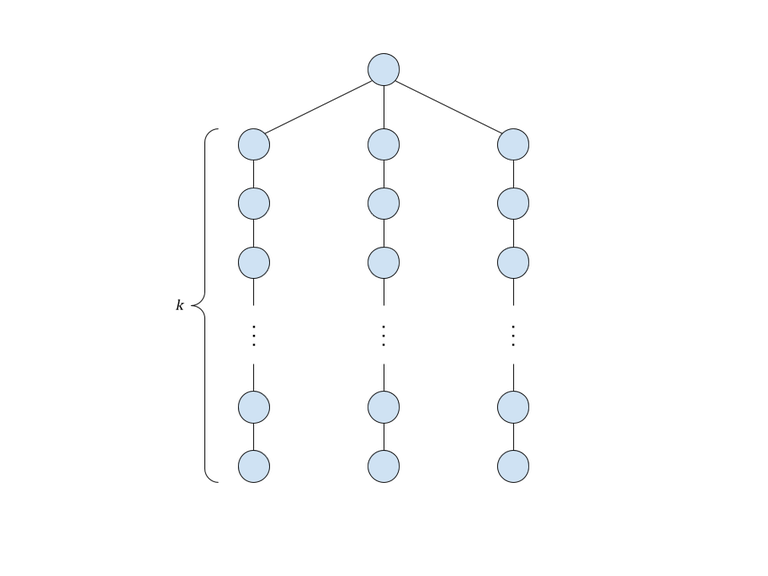It is not uncommon to have interactive tree problems where you are allowed to query some connected component of the tree and use the return value to determine whether the answer is in the connected component or outside the connected component (Link to example problem). The general approach for these kinds of problems is to always choose a connected component of size $$$\frac{N}{2}$$$. However, there are also problems where the allowed queries are more restricted, preventing $$$\frac{N}{2}$$$ halving from being possible. This blog covers one of those types of problems.
Definitions
- Subtree: $$$S(r, u)$$$ contains the set of vertices in the subtree of vertex $$$u$$$ if the tree was rooted at vertex $$$r$$$.
- Neighbour: $$$N(u)$$$ contains the set of vertices that are directly adjacent to vertex $$$u$$$.
- Extended subtree: $$$ES(r, V) = \bigcup_{v\in V} S(r, v)\text{ if } v\in N(r)$$$. In other words, an extended subtree is a combination of the subtrees of a chosen set of vertices that are directly adjacent to the root.
Problem Structure
There is a hidden special vertex in a tree with $$$n$$$ vertices. Find the special vertex using at most $$$\lceil\log_{1.5}n\rceil$$$ of the following query:
- Choose an extended subtree of the tree. The grader will return whether the special vertex is in the chosen extended subtree. More formally, choose any vertex $$$r$$$ and a subset of neighbours $$$V \subseteq N(r)$$$, then the grader will return whether the special vertex $$$x \in ES(r, V)$$$.
Solution
Let us denote the size of the chosen extended subtree as $$$x$$$. If the grader returns that the special vertex is in the extended subtree, we can combine the root with the extended subtree to form a new tree with $$$x + 1$$$ vertices. Otherwise, the vertices outside of the extended subtree form a tree with $$$n - x$$$ vertices. This means that with each query, we can reduce the size of the tree to at least $$$\max(x + 1, n - x)$$$.
Since we are allowed to use $$$\lceil\log_{1.5}n\rceil$$$ queries, we will be able to solve this problem if the size of the tree reduces to at least $$$\frac{2n}{3}$$$ after each query. Solving the inequality $$$\max(x + 1, n - x) \le \frac{2n}{3}$$$, we get $$$\frac{n}{3} \le x \le \frac{2n}{3} - 1$$$. Now, let us see whether it is always possible to find an extended subtree of size between $$$\frac{n}{3}$$$ and $$$\frac{2n}{3} - 1$$$.
Let us root the tree at its centroid. Recall that all the children of the centroid have subtree sizes less than or equal to $$$\frac{n}{2}$$$. If there exists a child with subtree size more than or equal to $$$\frac{n}{3}$$$, then that lone subtree can be the chosen extended subtree since $$$\frac{n}{3} \le x \le \frac{n}{2} \le \frac{2n}{3} - 1$$$ $$$^\dagger$$$. From this point onwards, we will assume that all children of the centroid have subtree sizes less than $$$\frac{n}{3}$$$.
We will add the children of the centroid one by one into the extended subtree until the first time that the size of the extended subtree becomes more than or equal to $$$\frac{n}{3}$$$. Note that this is always possible as taking all children will result in a size of $$$n - 1$$$ which is more than or equal to $$$\frac{n}{3}$$$. Let $$$x$$$ be the size of the resultant extended subtree and let $$$p$$$ be the size of the last child that was added into the extended subtree. We can obtain the following inequalities: $$$x \ge \frac{n}{3}$$$, $$$x - p < \frac{n}{3}$$$, and $$$p < \frac{n}{3}$$$. Combining the second and third inequality, we obtain $$$x < \frac{2n}{3}$$$. Hence, $$$\frac{n}{3} \le x \le \frac{2n}{3} - 1$$$ and the desired extended subtree is found.
$$$^\dagger$$$ Note that $$$\frac{n}{2} \le \frac{2n}{3} - 1$$$ might not be true when $$$n \le 5$$$, however, this is not very important as $$$n - 1 \le \lceil \log_{1.5} n \rceil$$$ when $$$n \le 5$$$, so we can just query every subtree except for vertex 1 to get the answer.
Optimality
It might feel like $$$\lceil\log_{1.5}n\rceil$$$ is a loose bound and we can do better. However, we can prove that it is not possible to do any better. Consider the tree below.

There are $$$n = 3k + 1$$$ vertices in the tree. The closest we can get to an extended subtree of size $$$\frac{n}{2}$$$ is either a single chain of size $$$k$$$ or two chains having size $$$2k$$$. Both of those options will result in a tree of size $$$2k + 1 \approx \frac{2n}{3}$$$ in the worst case after a query. This shows that for all $$$n = 3k + 1$$$, there exists a tree where it is not possible to reduce the size of the tree by less than $$$\frac{2n}{3}$$$ in a single query. We can use similar trees but with uneven chains to come up with a similar proof for $$$n = 3k + 2$$$ and $$$n = 3k + 3$$$ to obtain the proof for all $$$n$$$.
An issue with this proof is that it does not account for amortisation. For the tree that was shown above, even though it is not possible to reduce the size of the tree by less than $$$\frac{2n}{3}$$$ in the first query, the next query will be done on a single chain of length $$$2k + 1$$$, which makes it easy for the remaining queries to reduce the size of the chain by half each time. Hence, this proof is not quite complete yet and I would appreciate it if anyone could tell me if they come up with a new idea.






